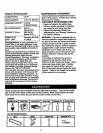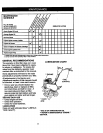
BEFORE STARTING ENGINE
IMPORTANT:Beverycarefulnotto allow
dirtto enterthe enginewhencheckingor
addingoilor fuel. Use clean oil and fuel
and store in approved, clean, covered con-
tainers, use clean fill funnels.
FILL ENGINE WITH OIL
• Remove hang tag from engine_
• With engine level, remove engine oil
filler plug.
• Fill engine with oil to point of overflow-
ing. For approximate capacity see
"PRODUCT SPECIFICATIONS" on page
4 of this manual.
• Tilt tiller back on its wheels and then re-
level.
• With engine level, refill to point of over-
flowing if necessary. Replace oil filler
plug.
• For cold weather operation you should
change oil for easier starting (See "OIL
VISCOSITY CHART" in the
Maintenance section of this manual).
• To change engine oil, see the
Maintenance section of this manual.
Oil Level
Oil Filler
Plug
ADD GASOLINE
• Fill fuel tank. Use fresh, clean, regular
unleaded gasoline. (Use of leaded
gasoline will increase carbon and lead
oxide deposits and reduce valve life.)
IMPORTANT: When operating in
Temperatures below 32°F (0°C), use fresh,
clean, winter grade gasoline to help insure
good cold weather starting.
WARNING: Experience indicates that
alcohol blended fuels (called gasohol or
using ethanol or methancT) can attract
moisture which leads to separation and
formation of acids during storage. Acidic
gas can damage the fuel system of an
engine while in storage. To avoid engine
problems, the fuel system should be emp-
tied before storage of 30 days or longer.
Drain the gas tank, start the engine and let
it run until the fuel lines and carburetor are
empty. Us9 fresh fuel next season.
See Storage section of this manual for
additional information.. Never use engine
or carburetor cleaner products in the fuel
tank or permanent damage may occur.
,_CAUTION: Fill to within 1/2 inch of top
of fuel tank to prevent spills and to allow
for fuel expansion. If gasoline is acciden-
tally spilled, move machine away from
area of spill. Avoid creating any source of
ignition until gasoline vapors have disap-
peared. Do not overfill. Wipe off any
spilled oil or fuel. Do not store, spill or use
gasoline near an open flame.
TO START ENGINE
,_CAUTION: Keep tine control in "OFF"
position when starting engine.
When starting engine for the first time or if
engine has run out of fuel, it will take extra
pulls of the recoil starter to move fuel from
the tank to the engine.
• Make sure spark plug wire is properly
connected.
• Place throttle control in =FAST" position.
• Move choke control to full "CHOKE"
position. Grasp recoil starter handle with
one hand and grasp tiller handle with
other hand. Pull rope out slowly until
engine reaches start of compression
cycle (rope will pull slightly harder at this
point).
• Pull recoil starter handle quickly. Do not
let starter handle snap back against
starter. Repeat if necassary.
• If engine tires but does not start, move
choke control to half choke position. Pull
recoil starter handle until engine starts.
• When engine starts, slowly move choke
control to "RUN" pos'dion as engine
warms up.
NOTE: A warm engine requires less chok-
ing to start.
• Move throttle control_to desired running
position.
• Allow engine to warm up for a few min-
utes before engaging tines.
NOTE: If at a high altitude (3000 feet) or
in cold temperatures (below 32°F), the car-
buretor fuel mixture may need to be
adjusted for best engine performance.
See "TO ADJUST CARBURETOR" in the
Service and Adjustments section of this
manual.
NOTE: If engine does not start, see trou-
bleshooting points.


















